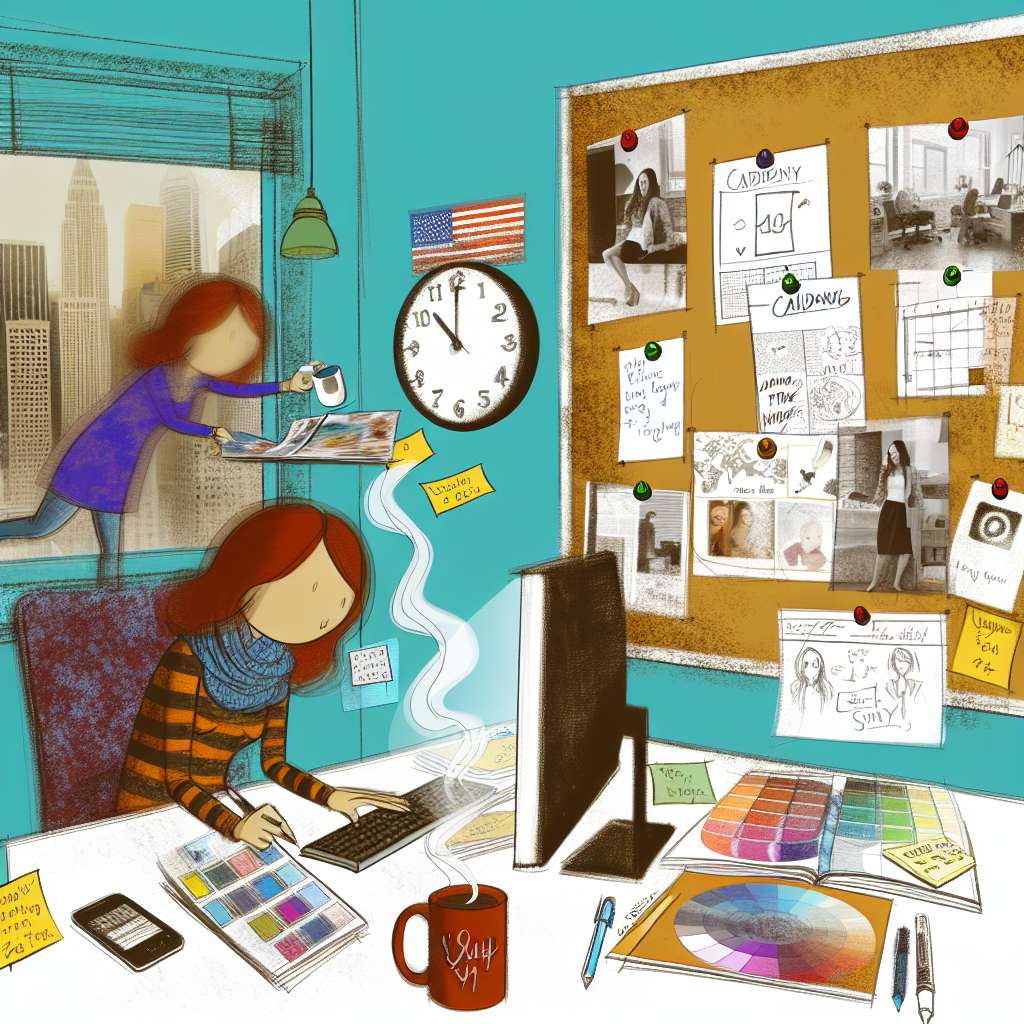Introduction
In the fast-paced world of magazine design, time management is crucial.
Designers juggle multiple projects with tight deadlines.
Effective time management leads to high-quality work and satisfied clients.
Define the Role of a Magazine Designer
A magazine designer creates visually appealing layouts for print and digital media.
They collaborate with writers, editors, and photographers to ensure cohesive content.
Designers choose typefaces, color schemes, and graphics to enhance storytelling.
Additionally, they ensure that each page aligns with the magazine’s brand identity.
Magazine designers also adapt their designs for different platforms, from smartphones to large prints.
This versatility enhances reader engagement and accessibility.
Highlight the Importance of Time Management in the Field
Time management is critical for magazine designers due to project timelines.
Designers often work under strict deadlines, requiring careful planning.
Poor time management can lead to rushed work and missed opportunities.
Effective time management enables designers to allocate time for brainstorming, revisions, and client feedback.
This organized approach results in a polished final product.
Furthermore, it reduces stress, allowing designers to focus on creativity.
By prioritizing tasks, designers can maintain a steady workflow.
Using tools like to-do lists and project management software can streamline processes.
Setting realistic goals and deadlines promotes accountability and efficiency.
Regular breaks can also boost creativity and productivity.
A well-managed schedule allows time for professional development, such as learning new software or techniques.
Transform Your Career Today
Unlock a personalized career strategy that drives real results. Get tailored advice and a roadmap designed just for you.
Start NowUltimately, mastering time management enhances a designer’s reputation and client satisfaction.
Effective Time Management for Magazine Designers
As a magazine designer, time management is crucial to ensure all projects are completed on time.
Managing time effectively helps meet artistic visions.
Adopting effective time management strategies can streamline your workflow and enhance productivity.
Here are key tips to improve your time management skills:
Create a Daily Schedule
One of the most effective ways to manage your time is by creating a daily schedule.
A well-structured day provides clarity and focus.
Here’s how to develop a successful daily plan:
- Start by mapping out your day: Write down all tasks to accomplish.
- Set specific time blocks: Allocate specific time slots to each task.
- Use digital tools or planners: Online calendars like Google Calendar can keep you organized.
- Include breaks: Schedule short breaks to recharge and maintain concentration.
- Review your schedule: At the end of each day, evaluate what you completed and adjust for tomorrow.
Following this daily schedule improves efficiency.
It ensures no tasks are overlooked.
Regularly reassessing your schedule allows for flexibility based on changing priorities.
Prioritize Tasks Based on Deadlines and Importance
Prioritization is essential for effective time management.
Not all tasks hold the same level of importance.
Use the following strategies to prioritize your tasks:
- Identify urgent projects: Highlight tasks that require immediate attention due to approaching deadlines.
- Evaluate importance: Determine which projects contribute most to your overall goals.
- Use a prioritization matrix: Create a grid to classify tasks by urgency and importance.
- Focus on high-impact tasks: Devote more time to tasks that benefit your magazine significantly.
- Review regularly: Adjust priorities as new tasks arise and deadlines shift.
By prioritizing tasks, you will focus your energy on what matters most.
This practice ensures that deadlines are met without sacrificing quality.
Additionally, working on high-priority projects first creates momentum for tackling other tasks.
Use Tools like Project Management Software to Stay Organized
Project management software can significantly streamline your design process.
These tools help keep teams organized and facilitate communication.
Showcase Your Business Today
Reach thousands of readers actively exploring professional services. Publish your business profile and grow your audience now.
Publish NowConsider implementing the following tools:
- Trello: Use Trello boards to visually manage your tasks.
- Asana: Employ Asana to create tasks, set deadlines, and track progress.
- Slack: Communicate effectively with team members using Slack channels.
- Adobe Creative Cloud: Leverage Adobe’s suite for collaboration on design projects.
- Notion: Use Notion for note-taking, task management, and documentation in one place.
These tools offer real-time updates, deadline alerts, and task assignments.
Staying organized with project management software reduces stress.
It also enhances team collaboration, keeping everyone on the same page.
Break Down Large Projects into Smaller Tasks
Large design projects can feel overwhelming.
Breaking them into smaller, manageable tasks simplifies your workflow.
Follow these steps to effectively decompose large projects:
- Identify key components: Look at each element of the project and list them out.
- Create actionable steps: Turn each component into specific, manageable tasks.
- Set deadlines for each task: Assign realistic timeframes for completing smaller jobs.
- Monitor progress: Regularly check off completed tasks to motivate yourself.
- Celebrate small wins: Acknowledge progress to maintain enthusiasm and commitment.
Breaking down projects helps reduce anxiety.
It allows you to track your progress better.
You will discover that smaller tasks feel less daunting and more achievable.
Implementing these time management techniques can transform your workflow.
By creating a daily schedule, prioritizing tasks, utilizing project management tools, and breaking down projects, you will improve your effectiveness as a magazine designer.
Adapting these strategies according to your unique needs can lead to increased productivity and a more satisfying design experience.
Review these tips regularly.
As deadlines approach or project scopes change, your strategies may need adjustment.
Continuous improvement in time management will enhance your skills and lead to better magazine designs.
Set Realistic Goals for Each Day
Setting achievable goals is essential for effective time management.
Without clear objectives, your work can feel overwhelming.
Start each day by outlining what you want to accomplish.
Define specific tasks that are both realistic and motivating.
Break larger projects into smaller tasks to avoid feeling daunted.
- Prioritize Tasks: Create a list of tasks in order of importance. Focus on high-impact activities first.
- Use S.M.A.R.T. Goals: Ensure each goal is Specific, Measurable, Achievable, Relevant, and Time-bound.
- Limit Daily Goals: Aim for a maximum of five goals each day. This prevents overload.
- Review Progress: At the end of the day, assess your achievements. Adjust your goals based on this reflection.
By setting realistic goals, you create a roadmap for your day.
This process enhances productivity and keeps you motivated.
Avoid Multitasking to Maintain Focus
Multitasking often leads to reduced efficiency and greater errors.
When you juggle multiple tasks, your mind cannot fully concentrate.
Focus on one task at a time to boost your performance and improve outcomes.
- Establish a Work Routine: Create a routine that allows you to dedicate specific blocks of time to each task.
- Use the Pomodoro Technique: Work for 25 minutes followed by a 5-minute break. This fosters concentration.
- Limit Distractions: Turn off notifications on your devices. This helps maintain your focus on the task ahead.
- Set Clear Boundaries: Inform colleagues of your focus time to minimize interruptions.
Concentrating on one task at a time enhances the quality of your work.
You’ll find that you complete things faster and with greater precision.
Delegate Tasks When Possible
Effective delegation is crucial in managing time efficiently.
As a magazine designer, you often juggle various responsibilities.
However, involving others can lighten your workload and enhance collaboration.
Identify tasks that others can handle.
- Assess Team Skills: Understand each team member’s strengths. Delegate tasks accordingly to maximize efficiency.
- Communicate Clearly: When delegating, provide clear instructions. Ensure everyone understands their responsibilities.
- Trust Your Team: Relinquish some control over specific tasks. Allow team members to take ownership.
- Follow Up: Check in periodically on delegated tasks. This keeps everyone accountable without micromanaging.
Delegating effectively allows you to focus on high-level design work.
It can also foster a collaborative environment within your team.
Take Breaks to Avoid Burnout and Maintain Productivity
Taking regular breaks is essential for sustaining productivity.
Prolonged work without rest can lead to mental fatigue and burnout.
Schedule short breaks throughout your day to refresh your mind.
- Incorporate Short Breaks: Every hour, take a 5- to 10-minute break. Use this time to stretch or grab water.
- Engage in Physical Activity: A quick walk can stimulate creativity and improve blood circulation.
- Meditate or Breathe: Practice mindfulness during breaks to reduce stress levels.
- Disconnect from Work: Reduce screen time during breaks. Engage in completely non-work-related activities.
Consistent breaks can rejuvenate your mind and body.
By prioritizing rest, you ensure sustained focus and creativity throughout your workday.
Time management is essential for magazine designers.
Showcase Your Business Today
Reach thousands of readers actively exploring professional services. Publish your business profile and grow your audience now.
Publish NowSetting realistic goals, avoiding multitasking, delegating tasks, and taking breaks significantly boosts productivity.
Consider implementing each of these practices into your daily routine.
Success in design hinges on creativity and effective management of time.
By mastering these strategies, you can elevate your work while maintaining balance in your life.
Discover More: Copywriting Courses and Certifications Worth Taking
Effective Communication for Magazine Designers
As a magazine designer, effective communication significantly streamlines our workflow.
When we communicate clearly, we reduce misunderstandings and enhance collaboration.
Here’s how to utilize effective communication to improve time management.
Communicate Effectively with Team Members
Establishing clear communication channels is vital.
Use emails, messaging apps, or project management tools.
Ensure everyone knows how and when to communicate.
- Define clear roles: Each team member must understand their responsibilities. Clarity prevents overlap and confusion.
- Use visual aids: Diagrams and flowcharts can illustrate complex ideas. Visuals help convey information more efficiently.
- Encourage open dialogue: Foster an environment where team members feel safe to share ideas. Open discussions lead to innovative solutions.
- Provide regular updates: Keep everyone informed about progress and changes. Frequent updates ensure everyone stays in sync.
- Listen actively: Pay attention to ideas and feedback from all members. Active listening fosters respect and collaboration.
These strategies create a more cohesive working environment, leading to improved productivity.
Schedule Regular Check-ins to Track Progress
Regular check-ins are crucial for keeping projects on track.
They provide a platform to discuss individual progress and address issues.
- Set a consistent schedule: Choose a time that works for everyone. Consistent meetings build accountability.
- Prepare an agenda: Identify key discussion points before each meeting. An agenda keeps the meeting focused and efficient.
- Assign roles during meetings: Designate a facilitator and a note-taker for each check-in. This structure improves organization.
- Summarize action items: End each meeting with a review of decisions and next steps. A clear summary helps maintain focus on goals.
- Utilize digital tools: Use applications like Trello or Asana to keep track of progress. Visual project management aids in understanding the bigger picture.
Regular check-ins transform project management from a reactive to a proactive approach.
Address Any Issues or Delays Promptly
Proactive problem-solving is key to avoiding setbacks.
Addressing issues quickly helps maintain momentum.
- Encourage prompt reporting: Foster a culture where team members report delays or issues as soon as they arise. Early reporting prevents escalation.
- Analyze the root cause: Investigate the reasons behind delays. Understanding root causes leads to effective solutions.
- Collaborate on solutions: Engage team members in brainstorming solutions to problems. Collaborative problem-solving enhances team cohesion.
- Realign priorities if necessary: When faced with significant delays, reassess project timelines. Adjusting priorities ensures that essential elements remain on track.
- Learn from setbacks: After resolving issues, review the processes involved. Learning from difficulties prepares the team for future challenges.
Promptly addressing problems not only resolves them but also builds trust within the team.
Collaborate on Timelines to Ensure Everyone Is on the Same Page
Collaborating on timelines fosters team unity.
Working together on schedules ensures everyone is aware and accountable.
- Develop a shared timeline: Utilize project management tools to create a visual timeline accessible to all team members. Shared timelines promote transparency.
- Identify dependencies: Recognize tasks that depend on others’ completion. Understanding dependencies helps manage expectations.
- Involve the team in deadline-setting: Collaboratively establish realistic deadlines that account for everyone’s workload. Involvement fosters commitment to timelines.
- Monitor progress against the timeline: Regularly check how the project aligns with the timeline. Adjustments may be necessary to stay on track.
- Celebrate milestones: Acknowledge and celebrate the completion of significant tasks. Celebrating milestones boosts morale and motivates the team.
By collaborating on timelines, the entire team works as a cohesive unit.
This tight alignment enhances productivity and retains focus on goals.
Effective communication, regular check-ins, prompt problem-solving, and collaborative timelines form the backbone of successful time management for magazine designers.
Embracing these practices facilitates smoother operations and ensures timely project completions.
In a fast-paced industry, time management directly impacts creativity and quality.
By prioritizing these strategies, magazine designers can remain organized and efficient, allowing them to create inspiring visual content.
With a focus on enhancing communication and collaboration, magazine designers can elevate their workflow.
Improving time management benefits the team and enriches the overall magazine production experience.
Ultimately, mastering these time management techniques enables magazine designers to navigate challenges more effectively.
As they harness the power of these practices, their contributions to the industry will only grow in significance.
Explore Further: How Web Content Managers Work with Marketing Teams
Use Time Tracking Tools to Analyze Productivity
As a magazine designer, maximizing productivity is crucial.
Time tracking tools can help you gain insights into your work.
These tools allow you to monitor how much time you spend on various tasks.
By keeping a detailed record of your activities, you can identify patterns in your workflow.
There are numerous time tracking tools available.
Here are a few popular options:
- Toggl
- Harvest
- Clockify
- RescueTime
- Timely
Each of these tools offers unique features.
They provide reports, analytics, and sometimes integrations with other software.
Using them can help you understand your productivity better.
Showcase Your Business Today
Reach thousands of readers actively exploring professional services. Publish your business profile and grow your audience now.
Publish NowYou can easily visualize how you allocate your time throughout the day.
Start by setting up your time tracking tool.
Define specific tasks you want to monitor.
This step ensures that you have clarity on what you need to measure.
Begin logging your hours diligently, and keep your tracking consistent.
Review your data regularly.
Look for trends and changes in your productivity.
You may find that certain tasks take more time than anticipated.
When you pinpoint these activities, you can analyze why they consume so much time.
Perhaps you lack the necessary resources or face frequent interruptions.
Identify Areas Where Time Is Being Wasted
Recognizing wasted time is essential for effective time management.
Start by examining your time tracking reports.
Check where your time goes, especially in regular tasks related to magazine design.
Consider categorizing your tasks.
For instance, divide them into groups such as:
- Design Development
- Client Communication
- Research and Trend Analysis
- Revisions and Edits
- Administrative Tasks
After sorting your tasks, calculate the time spent in each category.
This effort will reveal where you may waste time.
Pay special attention to tasks that consume excessive time without yielding valuable results.
Take note of frequent distractions.
Identify external influences that disrupt your focus.
These could include:
- Unnecessary meetings
- Email notifications
- Social media
- Chit-chats with coworkers
Once you detect areas of waste, it’s time to take action.
Eliminate or reduce inefficiencies wherever possible.
Consider streamlining communication with clients.
Set specific times for checking emails to avoid distractions.
Evaluate your meeting schedules and cut down on unnecessary gatherings.
Adjust Schedules and Workflows Accordingly to Optimize Time Management
After identifying time-wasting activities, adjust your workflow and schedules.
Start by setting goals for each project.
Creating clear objectives helps you stay focused and motivated.
Segment large projects into smaller, manageable tasks.
Allocate specific time slots for each task.
This approach gives you a clear sense of direction.
For example, if you work on a magazine spread:
- Design layout
- Select images
- Create typography
- Review and finalize
Assign deadlines for each task to promote accountability.
Use tools like Gantt charts or Kanban boards for visual organization.
These visuals provide a constant reminder of your deadlines.
They keep you on track and ensure you prioritize your workload effectively.
Incorporate buffer time into your schedule.
Life can be unpredictable, so allow flexibility for unexpected events.
Including buffer periods reduces stress when tasks take longer than expected.
Showcase Your Business Today
Reach thousands of readers actively exploring professional services. Publish your business profile and grow your audience now.
Publish NowMoreover, it fosters a work-life balance that enhances creativity.
Review your daily schedule regularly.
Determine which times of the day you feel most productive.
Adjust your most challenging tasks to align with your peak productivity periods.
Tackle design work when you feel the most focused.
Reserve mundane tasks for your least energetic moments.
Continuously Improve Processes Based on Data and Feedback
Time management is not a one-time effort.
It requires ongoing evaluation and adjustment.
Use the data you collect from your time tracking tools to refine your processes.
Solicit feedback from peers and clients.
They can provide valuable insights regarding your workflow.
Ask them about their experience while working with you.
For instance, inquire if communication was smooth or if deadlines were met.
Conduct regular assessments of your performance.
Set aside time weekly or monthly to review your time-tracking data.
Identify what strategies worked and which areas show room for improvement.
Implement changes based on your findings.
This may involve adjusting workflows, redefining tasks, or experimenting with new tools.
Be open to adapting your methods as needed.
Flexibility is crucial in an ever-changing design landscape.
Lastly, foster a habit of continuous learning.
Follow industry trends, attend workshops, and seek out best practices.
Stay updated with the latest design software that improves efficiency.
Learning new skills enriches your toolkit and maximizes productivity.
By actively implementing the above strategies, you will significantly improve your time management skills.
Each effort you make leads to better productivity and enhanced creativity as a magazine designer.
You Might Also Like: Building a Strong Voice for Sports Announcing

In the fast-paced world of magazine design, adaptability is key.
It is essential to be prepared for unexpected changes or last-minute requests.
Printing schedules, client feedback, and even team dynamics can shift at a moment’s notice.
Staying adaptable helps you manage such changes without losing momentum.
Staying Adaptable to Unexpected Changes
Learn how to stay adaptable by following these strategies:
- Maintain Open Communication: Regularly check in with your team and clients. Keep lines of communication open to discuss any changes that may arise.
- Watch Industry Trends: Staying informed about industry trends can prepare you for unexpected requests. Understanding client needs ensures a more seamless transition when changes occur.
- Practice Mindfulness: Work on staying present during stressful situations. Mindfulness reduces anxiety and promotes a flexible mindset.
- Keep a Positive Attitude: Embrace changes as opportunities for creativity. A positive outlook fosters collaboration and encourages innovative solutions.
Flexibility is about more than just reacting; it involves proactively planning for potential changes.
Have a Contingency Plan for Emergencies or Delays
Developing solid contingency plans is crucial to managing crises effectively.
Here are some essential steps for creating plans that work.
- Identify Potential Risks: Analyze past projects to pinpoint commonly encountered challenges. Knowing what to expect helps you prepare accordingly.
- Establish Backup Resources: Create a list of backup designers, writers, and photographers. This resource pool can save you when team members are unavailable.
- Prepare Time Buffers: Include extra time in your project schedules. These buffers provide breathing room for adjustments.
- Communicate Your Plans: Share your contingency plans with your team and clients. Clear communication lays the groundwork for effective emergency responses.
Having a contingency plan ensures that a last-minute change does not derail progress.
It helps maintain focus on delivering quality work.
Remain Flexible While Meeting Deadlines
Flexibility and deadlines can coexist harmoniously if managed well.
Consider these strategies for maintaining flexibility while meeting timeline demands.
- Set Realistic Deadlines: Ensure that deadlines reflect the complexity of the project. Discuss timelines with your team to build consensus and accuracy.
- Prioritize Tasks: Use a task management system to track project statuses. Prioritization enables you to identify critical tasks first.
- Practice Agile Methodology: Incorporate agile principles by breaking projects into smaller tasks. This approach allows for quick pivots based on team feedback.
- Monitor Progress: Regularly review project status to identify potential lagging areas. Early detection allows for swift reallocation of resources to meet deadlines.
Finding this balance will not only streamline your workflow but also enhance the quality of your designs.
Showcase Your Business Today
Reach thousands of readers actively exploring professional services. Publish your business profile and grow your audience now.
Publish NowLearn From Past Projects to Better Anticipate Future Challenges
Reflection is a powerful tool in magazine design.
By analyzing past projects, you can gain insights into managing future challenges effectively.
Here’s how to harness this learning:
- Conduct Post-Mortem Meetings: After project completion, hold meetings to discuss successes and failures. Gather feedback from your team on obstacles faced.
- Document Lessons Learned: Maintain a log of challenges encountered and solutions implemented. These notes can serve as a reference for future projects.
- Analyze Client Feedback: Review feedback from clients to identify areas of improvement. Use this feedback to tailor future designs to their preferences.
- Establish Best Practices: Create a set of best practices based on your reflections. This framework can guide your team through similar challenges in upcoming projects.
Learning from experience reinforces your ability to adapt and manage projects efficiently.
Each project becomes a stepping stone to better practices.
Implementing Adaptability in Your Daily Routine
To make adaptability a reflexive part of your workflow, incorporate these habits into your daily routine:
- Start With a Daily Review: Each morning, review your tasks and prioritize them. This sets a focused tone for your workday.
- Set Flexible Time Blocks: Allocate time for different tasks throughout your day. Allow buffer periods to accommodate urgent requests.
- Schedule Regular Breaks: Taking short breaks enhances creativity and flexibility. A fresh mind is more adaptable to changes.
- Engage in Team Brainstorming Sessions: Collaborate with your team regularly to discuss potential roadblocks. Group problem-solving fosters creative solutions.
By weaving these habits into your daily routine, you’ll foster a culture of adaptability.
This mindset encourages continuous improvement within your team.
Flexibility is integral to being a successful magazine designer.
Staying adaptable ensures you manage last-minute changes with ease.
Having contingency plans safeguards against emergencies and delays.
Flexibility in deadline management helps maintain high-quality designs.
Most importantly, learning from past projects equips you with the insight to navigate future challenges.
Embrace these strategies today to enhance your time management and overall effectiveness in the dynamic landscape of magazine design.
Uncover the Details: How to Pitch Your Film Project to Investors
Key Time Management Strategies for Magazine Designers
In the fast-paced world of magazine design, mastering time management is crucial.
You can streamline your workflow and boost productivity by applying key strategies.
First, prioritize your tasks effectively.
Use lists to identify what needs immediate attention.
Second, set realistic deadlines that reflect your design process.
Avoid overcommitting to prevent unnecessary stress.
Third, embrace technology.
Utilize design software and project management tools to enhance efficiency.
Recap Key Time Management Tips for Magazine Designers
Reviewing these strategies will empower your design process.
Begin each day by reviewing your task list.
Focus on high-impact projects that align with your deadlines.
Break larger projects into smaller, manageable tasks.
This approach keeps your momentum steady and motivation high.
Don’t forget to minimize distractions.
Create a dedicated, organized workspace that fosters creativity and focus.
Keep your digital workspace clean by organizing files and emails systematically.
Encourage Readers to Implement These Strategies
Now, take these time management tips and incorporate them into your daily routine.
Experiment with techniques until you find the right mix for your workflow.
Document your progress, and reassess your strategies regularly.
Small adjustments can lead to significant improvements.
Share your successes with peers and inspire others.
Collaboration can lead to further efficiency enhancements.
Importance of Effective Time Management
Effective time management in magazine design is not just a bonus—it’s essential.
It helps you meet deadlines, maintain client satisfaction, and produce quality designs.
Time is a designer’s most valuable resource.
Showcase Your Business Today
Reach thousands of readers actively exploring professional services. Publish your business profile and grow your audience now.
Publish NowUse it wisely to carve your path in the industry.
By applying these strategies, you can ensure a successful and fulfilling career as a magazine designer.
Empower yourself today to take control of your time and your projects.
Additional Resources
What Are the Best Skills for a Graphic Design Resume? | Indeed.com
[E-Books for Sale]
The Big Book of 500 High-Paying Jobs in America: Unlock Your Earning Potential
$19.99 • 500 High-Paying Jobs • 330 pages
Explore 500 high-paying jobs in America and learn how to boost your career, earn more, and achieve success!
See All 500 High-Paying Jobs of this E-Book
1001 Professions Without a Degree: High-Paying American Jobs You Can Start Now
$19.99 • 1001 Professions Without a Degree • 174 pages
Discover 1001 high-paying jobs without a degree! Unlock career tips, skills, and success strategies for just $19.99!




